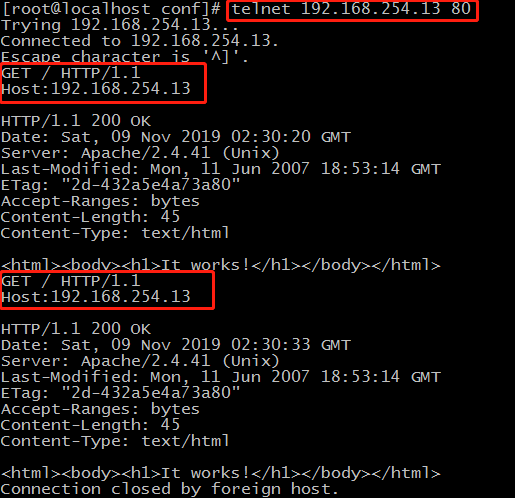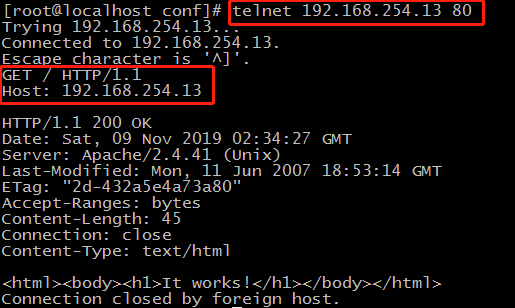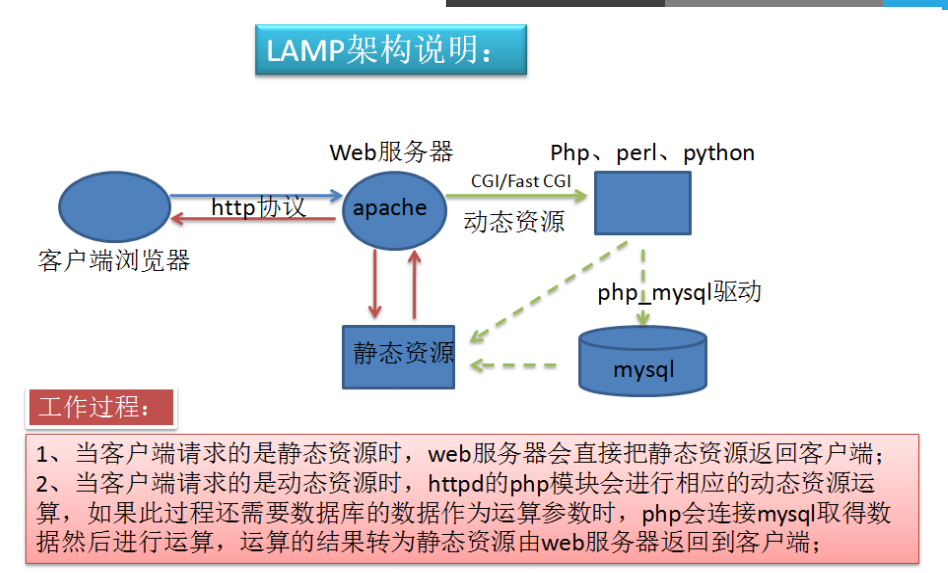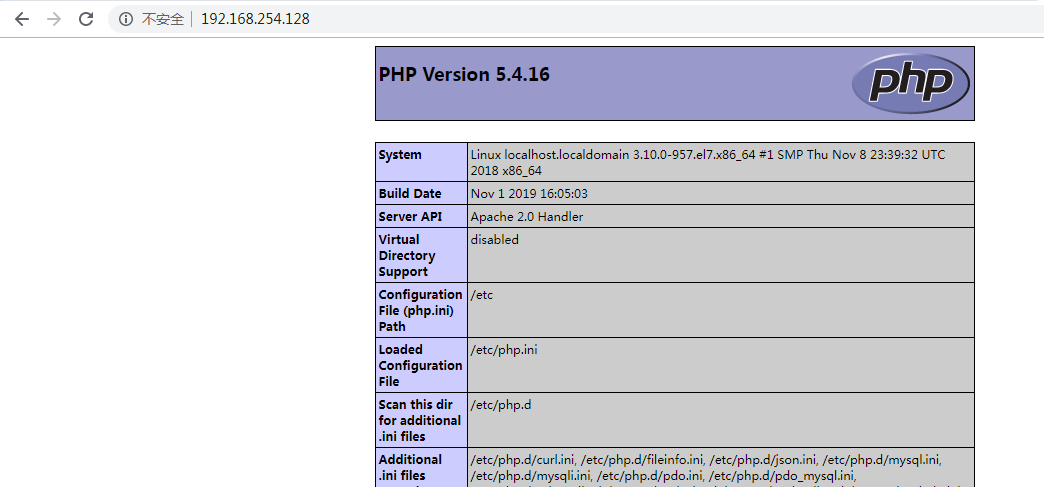apache2.4
介绍
Apache HTTP server是Apache软件基金会的一个开源的网页服务器,可以运行在几乎所有广泛使用的计算机平台上,由于跨平台和安全性被广泛使用,是目前最流行的web服务器软件之一,目前主流的web服务器软件包括Apache、Nginx、Lighttpd、IIS、Resin、Tomcat、Weblogic、jetty等
Apache服务器的特点是使用简单,速度快,性能稳定,可以作为负载均衡及代理服务器来使用
静态资源和动态资源
静态资源:静态内容,客户端从服务器获得的资源的表现形式与原文件相同
动态资源:通常是程序文件,需要在服务器执行之后,将执行的结果返回给客户端
状态码
HTTP状态码(英语:HTTP Status Code)是用以表示网页服务器超文本传输协议响应状态的3位数字代码。它由 RFC 2616 规范定义的,并得到 RFC 2518、RFC 2817、RFC 2295、RFC 2774 与 RFC 4918 等规范扩展。所有状态码的第一个数字代表了响应的五种状态之一。所示的消息短语是典型的,但是可以提供任何可读取的替代方案。 除非另有说明,状态码是HTTP / 1.1标准(RFC 7231)的一部分。
常见的状态码:
200:请求已成功,请求所希望的响应头或数据体将随此响应返回。 301:请求的URL指向的资源已经被删除,但在响应报文中通过Location指明了资源现在所处的新位置 302:与301相似,但在响应报文中通过Location指明资源现在所处临时新位置 304:如果客户端发送了一个带条件的 GET 请求且该请求已被允许,而文档的内容(自上次访问以来或者根据请求的条件)并没有改变,则服务器应当返回这个状态码 401:需要输入账号密码访问资源 403:请求被禁止 404:服务器无法找到客户端请求的资源 500:服务器内部错误 502:代理服务器从后端服务器收到一条伪响应
持久连接和非持久连接
2.持久连接 Persistent Connection:连接建立,每个资源获取完成后不会断开连接,而是继续等待其他请求的完成 如何断开? 数量限制:100 时间限制:可配置(http2.4可以配置毫秒) 副作用:对并发访问量较大的服务器,持久连接功能会使有些请求得不到响应 折中:较短的持久连接时间 3.非持久连接 http1.0默认是非持久连接 http1.1默认是持久连接 KeepAlive On|Off MaxKeepAlivedRequests # KeepAliveTimeout # 4.测试语法 telnet 192.168.254.12 80 GET / HTTP/1.1 Host: HOSTNAME or IP
长连接,一次连接好可以请求多个资源,直到等到设置的超时时间超时

短连接,在请求一个资源后立刻关闭连接

MPM
Multipath Process Module:多路处理模块,Apache 一共有3种稳定的 MPM 模式(多进程处理模块),它们分别是 prefork、worker、event。2.4版本的httpd默认是prefork工作模式。
而由于event不支持https,因此,企业里面很少使用event
- prefork模式
工作特点:
使用多个进程,每个进程只有一个线程,每个进程在某个确定的时间只能维持一个链接,优点是稳定,但内存开销较高
- worker模式
工作特点:
使用多个进程,每个进程包含多个线程,每个线程在某个确定的时间只能维持一个链接,内存占用比较小,适合大并发,高流量的web服务器worker缺点是一个线程崩溃,整个进程就会连同其任何线程一起挂掉
- event模式
不支持https
修改MPM模块
[root@localhost modules]# vim /etc/httpd/conf.modules.d/00-mpm.conf
解开注释:LoadModule mpm_worker_module modules/mod_mpm_worker.so
然后重启服务:
[root@localhost modules]# systemctl restart httpd
查看:
[root@localhost modules]# httpd -V
AH00112: Warning: DocumentRoot [/www/web1/] does not exist
AH00558: httpd: Could not reliably determine the server's fully qualified domain name, using localhost.localdomain. Set the 'ServerName' directive globally to suppress this message
Server version: Apache/2.4.6 (CentOS)
Server built: Aug 8 2019 11:41:18
Server's Module Magic Number: 20120211:24
Server loaded: APR 1.4.8, APR-UTIL 1.5.2
Compiled using: APR 1.4.8, APR-UTIL 1.5.2
Architecture: 64-bit
Server MPM: worker
threaded: yes (fixed thread count)
forked: yes (variable process count)
安装apache2.4
[root@localhost modules]# yum install httpd -y
[root@localhost modules]# systemctl restart httpd
修改apache端口号
1.Listen:[ip]:PORT
省略ip表示监听本机所有ip;Listen可以出现多次
定义默认主页面
DirectoryIndex index.html index.html.var
日志
apache日志一般分为两类,1.错误日志,2.访问日志
错误日志:一般存放apache所生成的错误信息
[root@localhost ~]# cat /etc/httpd/conf/httpd.conf | grep "^Error" ErrorLog "logs/error_log"
访问日志:记录着访问本网站的客户端信息,例如ip等
[root@localhost ~]# vim /etc/httpd/conf/httpd.conf <IfModule log_config_module> # # The following directives define some format nicknames for use with # a CustomLog directive (see below). # LogFormat "%h %l %u %t \"%r\" %>s %b \"%{Referer}i\" \"%{User-Agent}i\"" combined LogFormat "%h %l %u %t \"%r\" %>s %b" common <IfModule logio_module> # You need to enable mod_logio.c to use %I and %O LogFormat "%h %l %u %t \"%r\" %>s %b \"%{Referer}i\" \"%{User-Agent}i\" %I %O" combinedio </IfModule> # # The location and format of the access logfile (Common Logfile Format). # If you do not define any access logfiles within a <VirtualHost> # container, they will be logged here. Contrariwise, if you *do* # define per-<VirtualHost> access logfiles, transactions will be # logged therein and *not* in this file. # #CustomLog "logs/access_log" common # # If you prefer a logfile with access, agent, and referer information # (Combined Logfile Format) you can use the following directive. # CustomLog "logs/access_log" combined </IfModule>
访问日志格式
combined和common:复合型和普通型
LogFormat "%h %l %u %t \"%r\" %>s %b \"%{Referer}i\" \"%{User-Agent}i\"" combined LogFormat "%h %l %u %t \"%r\" %>s %b" common
含义:
%h:远端主机 %I:远端登录名 %u:远程用户名 %t:时间 %r:请求第一行 %>s:状态 %b:传送字节 %{Referer}i\:请求来源 \"%{User-Agent}i\:客户端浏览器提供的浏览器识别信息
站点访问控制
站点访问控制 可基于两种类型的路径指明对哪些资源进行访问控制 文件系统控制: <Directory ""> </Directory> <File ""> </File> <FileMatch ""> </FileMatch> URL路径: <location ""> </location> ...
基于"来源地址"的访问控制
Directory中"基于来源地址"实现访问控制 (1)Options Indexes Includes FollowSymLinks SymLinksifOwnerMatch ExecCGI MultiViews None All Indexes: 如果没有默认主页面也找不到自定义页面会显示索引页面 (2)基于来源地址的访问控制机制 Require all granted
Require all denied 来源地址:
Require ip IPADDR
Require not ip IPADDR IPADDR: 192.168 192.168.0.0 192.168.0.0/24 192.168.0.0/255.255.255.0
示例:
<Directory "/var/www/admin">
AllowOverride None
Options None
#Require all granted
Require not ip 192.168.254.0/24
</Directory>
基于"用户"的访问控制
基于用户访问控制 <Directory "/var/test"> AllowOverride None Options None AuthType Basic AuthName "this is admin page" AuthUserFile "/etc/httpd/conf.d/.htpasswd" Require user admin1 admin2 admin3 </Directory> 创建访问授权账号 -c:自动创建htpasswd文件,因此,仅应该在添加第一个用户时使用 -m:md5加密 -D:删除用户 htpasswd -c -m /etc/httpd/conf.d/.htpasswd admin1 htpasswd -m /etc/httpd/conf.d/.htpasswd admin1
基于"组"的访问控制
12.基于组访问控制 <Directory "/var/test"> AllowOverride None Options None AuthType Basic AuthName "this is admin page" AuthUserFile "/etc/httpd/conf.d/.htpasswd" AuthGroupFile "/etc/httpd/conf.d/.htgroup" Require group webadmins </Directory>
虚拟主机
有三种实现方案: 基于IP: 为每个虚拟主机准备至少一个ip 基于port: 为每个虚拟主机准备至少一个port 基于hostname: 为每个虚拟主机准备至少一个hostname 可以混合使用上述三种方式中任意方式 note:一般虚拟主机不要和中心主机混用,所以要使用虚拟主机,请先禁用虚拟主机 禁用中心主机:注释DocumentRoot 每个虚拟主机都有专门配置: <VirtualHost "IP:PORT"> ServerName: DocumentRoot </VirtualHost> 示例: <VirtualHost 192.168.254.12:80> ServerName www2.cl7.com DocumentRoot "/var/www/www2" ErrorLog logs/www2-error_log CustomLog logs/www2-access_log combiend <Directory "/var/www/html1"> Options None AllowOverride None <RequireAll> Require not ip 192.168.1.0/24 Require all granted </RequireAll> </Directory> </VirtualHost>
lamp架构
lamp架构是linux,apache,mysql,php的缩写,以下是架构图

测试apache和php的连接
安装php和mysql的驱动程序
[root@localhost ~]# yum install php php-mysql
在/var/www/html下(如果没有修改路径的话)创建index.php,添加如下内容
[root@localhost ~]# vim /var/www/html/index.php <?php phpinfo(); ?>
验证:

ok,成功
测试php和mysql(mariadb)的连接
在/var/www/html下(如果没有修改路径的话)创建index.php,添加如下内容:
[root@localhost ~]# vim /var/www/html/index.php <?php $link=mysql_connect('127.0.0.1','root','root'); if($link) echo "success!!!"; else echo "failed!!!"; mysql_close(); ?>
测试

ok,没问题


 浙公网安备 33010602011771号
浙公网安备 33010602011771号